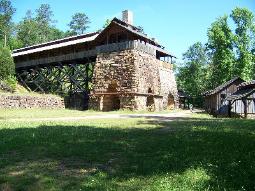nBirmingham.net
History of Iron and Steel Production in Birmingham, Alabama
The iron and steel industry played a major role
in the development of the modern South,
particularly in the state of Alabama.
Iron and steel production was the foundation
upon which the city of Birmingham was built and
also gave rise to other important communities in
the state, including nearby Anniston. The
industry has a rich history in Alabama and
undoubtedly the best place to explore it is the
Alabama Iron and Steel Museum.
Located at
Tannehill Ironworks Historical State Park
near Birmingham, the museum explores the role
that iron and steel production have played in
the development of the state. Visitors to the
outstanding museum can explore displays that
allow them to walk through the history of iron
and steel production in Alabama. Displays
feature rare artifacts from the industry's past
and life-sized exhibits demonstrating different
aspects of the work involved in the production
of the iron and steel that helped fuel the
country's industrial explosion.
The exhibits focus around the operation of the
ironworks at Tannehill in particular. These
furnaces helped produce thousands of tons of
iron for the Confederate war effort before they
were destroyed by Union troops during
Wilson's Raid through Alabama and Georgia.
Displays in the museum include artillery shells
and a cannon produced using Alabama iron.
Just as it became in later years for the nation
as a whole, the
state of Alabama
was a vital center of iron production for the Confederate
states during the Civil War. This industry that
proved so vital to the Southern war effort can
be explored at the remarkable Tannehill Ironworks Historical State Park.
ocated in off Interstate 59 less than 30 minutes from downtown Birmingham, Tannehill was a major facility for the production of iron during the Civil War. The
well-preserved site has been beautifully restored and now is the focal point of a park
that is among the finest in the state.
The production of iron at the site actually began in 1830 when Daniel Hillman built a forge on the banks of Roupes Creek. He died within two years and the facility was taken over by Ninian Tannehill, who operated it as
a sideline to his more profitable farming operation.
In 1859, however, the small forge evolved into something much greater. A slave labor force began work on the massive Tannehill No. 1 furnace, designed by ironmaster Moses Stroup. Over the next four years, hundreds of slaves hand cut sandstone blocks and pulled them on skids to the site for use in the building of three large blast
furnaces.
 By 1863, the Tannehill Ironworks could produce 22 tons of desperately needed iron per day. Used for the casting of artillery, cookware and even cast iron stoves for the Confederate army, the iron produced at Tannehill contributed significantly to the Southern war effort. Around 500 workers lived
in cabins on the site and the facility also included a gristmill, tannery and tax-in-kind
warehouse. By 1863, the Tannehill Ironworks could produce 22 tons of desperately needed iron per day. Used for the casting of artillery, cookware and even cast iron stoves for the Confederate army, the iron produced at Tannehill contributed significantly to the Southern war effort. Around 500 workers lived
in cabins on the site and the facility also included a gristmill, tannery and tax-in-kind
warehouse.
Remarkably, Tannehill operated to within one
week of the surrender of Robert E. Lee. The death blow to the facility finally came on March 31, 1865, when it was targeted by the troops of Union General James Wilson.
As Wilson and his men pushed south through Alabama, they targeted the iron facilities throughout the central part of the
state. Three companies from the 8th Iowa Cavalry seized Tannehill on March 31st and by the end of the day, the wooden parts of the
facility had been reduced to ashes and the massive stone furnaces were no longer operational.
|